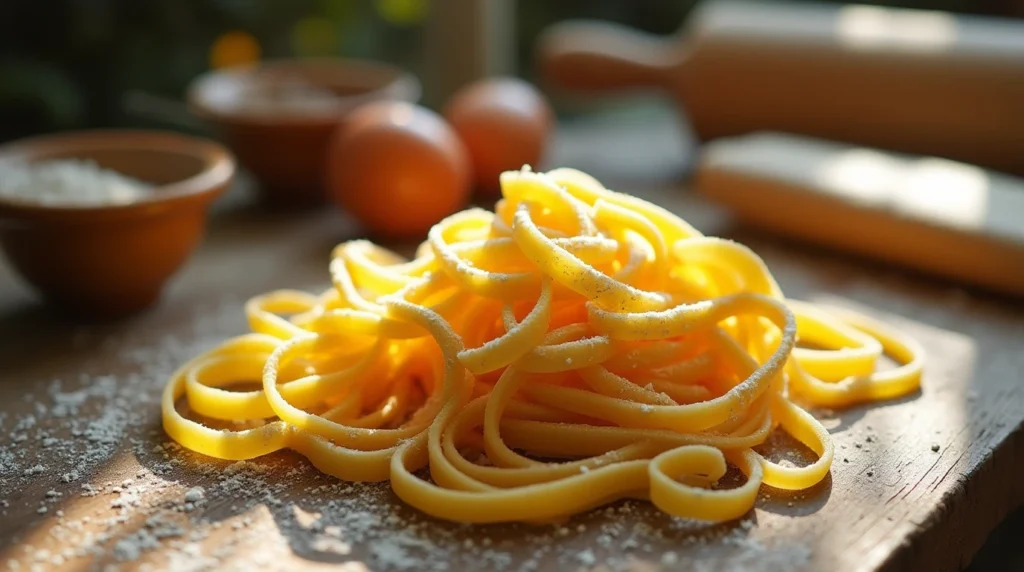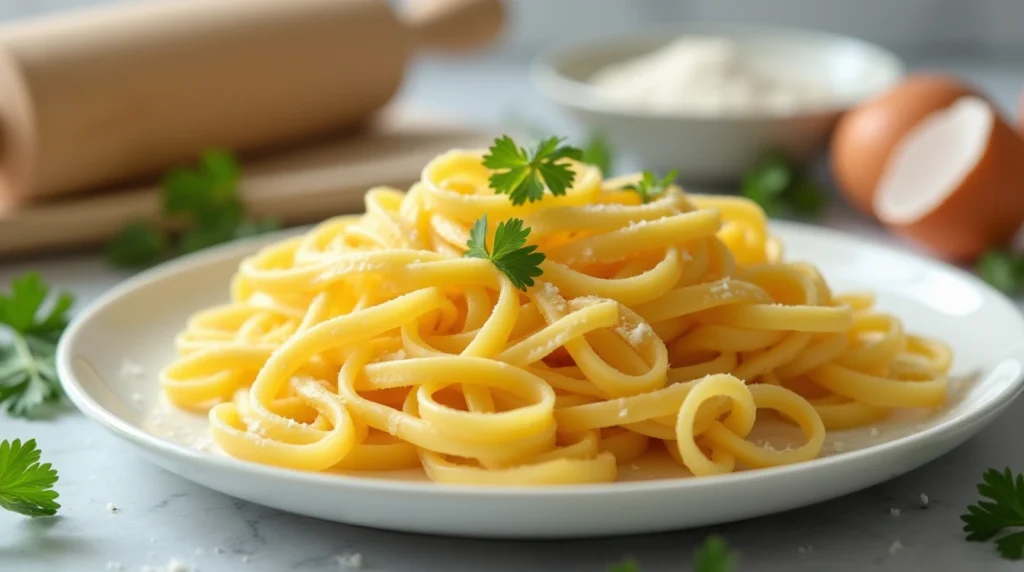Are you searching for a tasty and flexible pasta substitute? Gluten-free egg noodles could be just what you need. This guide will show you how to make homemade egg noodles that are both tasty and good for those with gluten issues. You’ll need gluten-free flour, tapioca starch, eggs, and water to create a delicious meal.
With a few easy steps and some helpful tips, you can make gluten-free egg noodles. They’ll become a favorite in your kitchen.

In this article, we’ll dive into the health perks of gluten-free diets. We’ll also cover various cooking methods and the best ingredients to use. Making gluten-free pasta at home is easy and very rewarding.
Key Takeaways
- The dough benefits from a resting period of approximately 30 minutes.
- Cook noodles until they reach al dente texture, about 2 minutes.
- Fresh noodles can be stored in the refrigerator for up to 3 days.
- Freezing uncooked noodles is ideal for use within 2 months.
Introduction
Gluten-free egg noodles are a tasty option for those on a gluten-free diet. They have a rich taste that’s similar to traditional noodles. Made with gluten-free flours, eggs, and a few extra ingredients, they satisfy pasta cravings without dietary limits.
Gluten-free pasta making is becoming more popular. It uses ingredients like corn, rice, and potato flour instead of wheat. With 1% of Americans having Celiac disease and 6% gluten intolerant, the need for good gluten-free options is growing.
These noodles are great for many dishes. They’re perfect for soups, stir-fries, and casseroles. They cook quickly, which is great for busy weeknights. Many people prefer them over traditional pasta because of their taste.

Why Choose Gluten-Free Egg Noodles?
Gluten free egg noodle are great for those who care about their health and dietary choices. They are perfect for people with gluten sensitivities or anyone looking to try new gluten-free recipes.
Health Benefits of Gluten-Free Diets
Going gluten-free can greatly improve life for those with celiac disease. It affects about 1 in 100 people globally. Symptoms like bloating and fatigue often go away when gluten is removed from the diet.
Gluten-free egg noodles are made with ingredients like rice flour and potato starch. These are often more nutritious than wheat-based noodles. They also have calcium, magnesium, and iron, and are made with protein-rich eggs. This makes them a healthier choice.
Versatility in Cooking
Gluten-free egg noodles are very versatile. They can be used in soups, stews, and casseroles. This makes them a staple for those who follow a gluten-free diet.
Brands like Jovial and Manischewitz offer high-quality gluten-free options. These allow for creative and delicious meals. This means people on gluten-free diets can enjoy a wide range of flavors and textures.

Essential Ingredients for Gluten-Free Egg Noodles
Making gluten-free egg noodles needs the right ingredients. Each one adds to the taste and texture. Knowing the best mix of gluten-free flour and other ingredients is key.
Gluten-Free Flour Options
The base of gluten-free egg noodles is a good gluten-free flour blend. You can use Better Batter or Bob’s Red Mill 1:1 Gluten-Free Flour. These blends mix different flours for the right feel.
For a basic recipe, use 2½ cups of gluten-free flour blend and 30g of gluten-free tapioca flour. Always measure the flour by spoon and level. This ensures the right dough texture.
The Role of Eggs in Noodle Texture
Eggs are crucial for gluten-free egg noodles. They add richness and texture. You’ll need three whole eggs and an extra egg yolk.
This mix improves the taste and makes the noodles tender. They become satisfying and fun to eat.
Additional Ingredients: Salt and Xanthan Gum
A pinch of salt, about ½ teaspoon, boosts the flavor of gluten-free noodles. Xanthan gum is also important. It helps the dough stick together without gluten.
If your flour blend has xanthan gum, don’t add it. This prevents the dough from getting too sticky.
Preparation: Making the Dough
Making homemade gluten-free egg noodles starts with the right dough preparation. This ensures the dough is smooth and elastic. You’ll need to mix the ingredients and knead the dough well. Here are the key steps to follow.
Mixing Ingredients
First, gather your ingredients. You’ll need 10 oz (about 2 cups) of gluten-free flour, like Bob’s Red Mill Gluten Free 1 to 1 Baking Flour. Also, add 60 grams (1/2 cup) of tapioca starch and 3 grams (1 teaspoon) of xanthan gum. Don’t forget ½ teaspoon of salt for flavor.
Make a well in the dry ingredients and crack in four whole eggs plus one egg yolk. Add a tablespoon of water. Gently mix the wet and dry ingredients until a shaggy dough forms.
Kneading Techniques for Optimal Texture
Kneading is crucial for a smooth dough. Move the dough to a floured surface, using tapioca flour to prevent sticking. Knead for 5 to 7 minutes until it’s slightly tacky but not too sticky.
Let the dough rest for 30 minutes after kneading. This step helps the ingredients blend better. It also makes rolling out the dough easier, resulting in perfectly cooked noodles.
| Ingredient | Measurement |
|---|---|
| Gluten-Free Flour | 10 oz (285g, about 2 cups) |
| Tapioca Starch | 60 grams (1/2 cup) |
| Xanthan Gum | 3 grams (1 teaspoon) |
| Salt | ½ teaspoon |
| Whole Eggs | 4 eggs |
| Egg Yolk | 1 egg yolk |
| Water | 1 tablespoon |
Shaping Your Noodles
Making gluten-free egg noodles is all about the shaping and cutting. It starts with rolling out the dough. This lets you create different noodle shapes for your meals.
Rolling Out the Dough
Start by splitting the rested dough into smaller pieces. Use a rolling pin or pasta machine to make each piece thin. Aim for a thickness of 1/16 to 1/8 inch. Dusting the surface and dough with flour helps prevent sticking.
Cutting Techniques: Strips or Shapes
You can cut noodles into many shapes and sizes. Use a knife or pizza cutter for strips or other shapes. Folding the dough before cutting helps get even widths. A pasta machine can also help you get precise shapes.
Cooking Gluten-Free Egg Noodles
To make your homemade gluten-free egg noodle perfect, knowing how to cook them is key. The right way to cook can make them taste better and feel softer. Here are some important pasta cooking tips to help you.
Boiling Water Essentials
Begin by heating a big pot of salted water until it boils. Having enough water is important to stop the noodles from sticking together. Use 4-6 quarts of water for every pound of noodles. Salt in the water makes the noodles taste better.
Cooking Time for Perfect Noodles
When the water boils, add your gluten-free egg noodles gently. They usually take 8 to 12 minutes to cook, depending on their thickness. Start checking if they’re done after 5 minutes. Taste one to see if it’s al dente. After cooking, drain the noodles right away to stop them from getting overcooked.
Follow these steps for a delicious pasta dish that’s perfect for anyone who eats gluten-free.
Storing and Freezing Leftover Noodles
It’s important to store gluten-free noodles right to keep them tasty and fresh. You should use different methods for leftovers and raw noodles. Knowing how to refrigerate and freeze will make your meals easy and tasty.
Tips for Refrigeration
Cooked gluten-free egg noodles can be stored in the fridge for later. Put them in a sealed container and keep them for up to three days. Make sure the noodles are cool before sealing to avoid sogginess.
Freezing Techniques for Future Use
Freezing pasta keeps your noodles fresh for later. To freeze uncooked noodles, lay them flat on a baking sheet for an hour. Then, put them in a freezer-safe bag or container. Cooked noodles can also be frozen, best consumed within three months.
Freezing cooked noodles in batches of two to four cups is a good idea. You can also freeze them in “nests” of spaghetti. Remove air from bags to prevent freezer burn. To thaw, soak them in warm water, stir them into your dish, or dip in boiling water for a minute.
Recipes to Enjoy with Gluten-Free Egg Noodles
Gluten-free egg noodles are great for many recipes, like comfort foods and quick stir-fries. They’re perfect in soups and stir-fries, adding flavor and texture. Here are some tasty ways to use them in your cooking.
Comfort Food Ideas: Soups and Stroganoff
This noodle is perfect for classic dishes. It adds a nice chewiness, making it great with rich sauces and broths. Here are some favorites:
- Chicken Noodle Soup: Mix gluten-free egg noodles with chicken, veggies like carrots and celery, and chicken broth for a cozy meal.
- Beef Stroganoff: Make a creamy beef stroganoff with sautéed beef, mushrooms, and a sauce over noodles for a tasty dinner.
Stir-Fry Combinations
Gluten-free egg noodles soak up flavors in stir-fries, making them delicious. Here are some stir-fry ideas:
- Vegetable Stir-Fry: Sauté bell peppers, broccoli, and carrots with garlic and soy sauce, then add noodles for a healthy meal.
- Meat Lo Mein: Mix your favorite protein, veggies, and gluten-free sauces in a hot pan for a quick, tasty dish.
Enjoy your gluten-free egg noodles in any way you like. They cook quickly, in 2 to 5 minutes. Adding gluten-free sauces or broths can make your meals even more special and flavorful.
Conclusion
Gluten-free egg noodles are a great cooking project for those on a gluten-free diet. As more people learn about gluten intolerance, the need for gluten-free foods grows. Making your own noodles lets you enjoy tasty, custom-made dishes without losing flavor or texture.
Using high-quality ingredients like chickpea flour can make your noodles even better. This article shows you how to make great gluten-free egg noodles. It also makes cooking more fun and rewarding, adding to the joy of a gluten-free lifestyle.
Gluten-free egg noodles are a fantastic addition to any kitchen. They open up a world of possibilities for cooking, allowing you to make traditional noodle dishes that fit your dietary needs. Start making your own noodles and explore the many delicious variations they offer.
FAQ
1. Are any egg noodles gluten-free?
Most egg noodles contain wheat and are not gluten-free, but gluten-free options made from rice or other flours are available.
2. What is a good substitute for egg noodles?
Gluten-free pasta, rice noodles, zoodles (spiralized vegetables), or 100% buckwheat soba noodles.
3. Are ramen egg noodles gluten-free?
No, traditional ramen noodles are made with wheat, but gluten-free versions exist.
4. Are soba egg noodles gluten-free?
Not always. Many soba noodles include wheat. Look for 100% buckwheat soba noodles.
5. What is the difference between egg-free and egg noodles?
Egg noodles contain eggs for a rich flavor. Egg-free noodles lack eggs and are suitable for vegans or those with egg allergies.
6. Can I just crack an egg into my noodles?
Yes! Add an egg to boiling noodles for a poached or stirred egg-drop effect.
Let me know if you’d like more details!
Discover more easy and delicious recipes by visiting our site

